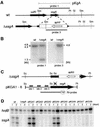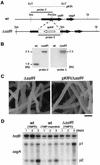Transcriptional switch on of ssgA by A-factor, which is essential for spore septum formation in Streptomyces griseus
- PMID: 12562798
- PMCID: PMC142869
- DOI: 10.1128/JB.185.4.1273-1283.2003
Transcriptional switch on of ssgA by A-factor, which is essential for spore septum formation in Streptomyces griseus
Abstract
A-factor (2-isocapryloyl-3R-hydroxymethyl-gamma-butyrolactone) triggers morphological development and secondary metabolism in Streptomyces griseus. A transcriptional activator (AdpA) in the A-factor regulatory cascade switches on a number of genes required for both processes. AdBS11 was identified in a library of the DNA fragments that are bound by AdpA and mapped upstream of ssgA, which is essential for septum formation in aerial hyphae. Gel mobility shift assays and DNase I footprinting revealed three AdpA-binding sites at nucleotide positions about -235 (site 1), -110 (site 2), and +60 (site 3) with respect to the transcriptional start point, p1, of ssgA. ssgA had two transcriptional start points, one starting at 124 nucleotides (p1) and the other starting at 79 nucleotides (p2) upstream of the start codon of ssgA. Of the three binding sites, only sites 1 and 2 were required for transcriptional activation of p1 and p2 by AdpA. The transcriptional switch on of ssgA required the extracytoplasmic function sigma factor, sigma(AdsA), in addition to AdpA. However, it was unlikely that sigma(AdsA) recognized the two ssgA promoters, since their -35 and -10 sequences were not similar to the promoter sequence motifs recognized by sigma(BldN), a sigma(AdsA) homologue of Streptomyces coelicolor A3(2). An ssgA disruptant formed aerial hyphae, but did not form spores, irrespective of the carbon source of the medium, which indicated that ssgA is a member of the whi genes. Transcriptional analysis of ssfR, located just upstream of ssgA and encoding an IclR-type transcriptional regulator, suggested that no read-through from ssfR into ssgA occurred, and ssgA was transcribed in the absence of ssfR. ssgA was thus found to be controlled by AdpA and not by SsfR to a detectable extent. SsfR appeared to regulate spore septum formation independently of SsgA or through interaction with SsgA in some unknown way, because an ssfR disruptant also showed a whi phenotype.
Figures








References
-
- Ando, N., K. Ueda, and S. Horinouchi. 1997. A Streptomyces griseus gene (sgaA) suppresses the growth disturbance caused by high osmolality and a high concentration of A-factor during early growth. Microbiology 143:2715-2723. - PubMed
-
- Ausubel, F. M., R. Brent, R. E. Kingston, D. O. Moore, J. S. Seidman, J. A. Smith, and K. Struhl. 1987. Current protocols in molecular biology. John Wiley & Sons, Inc., New York, N.Y.
-
- Beck, E., G. Ludwig, E. A. Auerswald, B. Reiss, and H. Schaller. 1982. Nucleotide sequence and exact localization of the neomycin phosphotransferase gene from transposon Tn5. Gene 19:327-336. - PubMed
Publication types
MeSH terms
Substances
Associated data
- Actions
LinkOut - more resources
Full Text Sources

